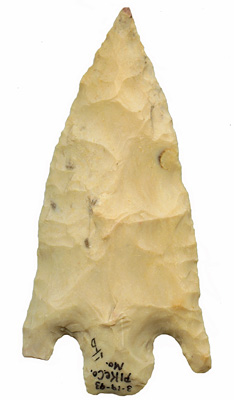

Point Type: MEHLVILLE
Also See: Andice, Bell, Bristol
Diagonal Notched, Castroville, Calf Creek, Eva, Grundy, Kline, Lost Lake, Ocala
Location: Midwestern States - Especially West- Central Illinois and Northeastern Missouri
Associated Dates: 4,000 - 3,000 B.P. - Late Archaic
Morphology: Basal
Notched
General Description: The Mehlville point
type is a large triangular point which has basal notches and a
short rectangular stem which tends to contract slightly. The blade is broad and triangular in
outline usually having convex to recurved
blade edges. The shoulders are
deeply barbed. The barbs are squared,
rounded or pointed and on some specimens droop inward. The basal
notches are V-shaped.
The Mehlville's primary use
location was West-Central Illinois and the northeastern part of
Missouri. The major area of distribution is
near St. Louis and the mouth of the Missouri River
and generally around 100 miles from that point. It has been reported that some Mehlville
point may be found in northern Arkansas.
The
Mehlville size ranges from 60 to 140 mm with the average size being 90
mm.
The typical material used in manufacture was Mozartkite and
Kaolin chert or other white cherts.
Perino
suggests that the Mehlville as been often referred to as the Smith type but
the Mehlville has a different shape from the Smith, being triangular, which
the Smith point has parallel sides.
The type was named by Gregory Perino from a point type
found in a cache of eight points near Mehlville, Missouri in 1970 by David
Hoefelmann in a road grading operation.
About The Point Above: The magnificent Mehlville point
pictured
at the top of this page, is from Greene
County, Missouri and is from Pike County, Missouri and is from the
former Tom Davis collection. It appears to be made from what appears to
be a satin cream colored Kaolin chert which has a few darker tan inclusions. The point is 87
mm long, 44 mm wide at the barbs and is 10 mm at its thickest point
(at mid blade) with the blade being 6.5 mm in typical thickness. The stem is 16 mm
wide with the base and notches showing no signs of being ground. The left wing or barb
which is the short wing may have had ancient barb damage. Catalog Number
162-155-V
References: Overstreet, Perino (1)
© Copyright 1997 - 2009 LITHICS-Net WWW.LITHICSNET.COM
Use Your Browser's BACK Button to Return to the LITHICS-Net Index.